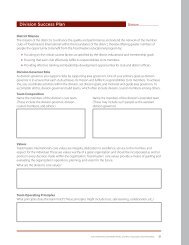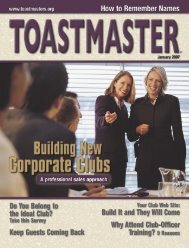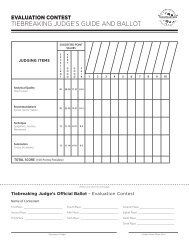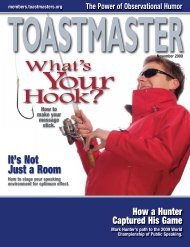SERGEANT AT ARMS - Toastmasters International
SERGEANT AT ARMS - Toastmasters International
SERGEANT AT ARMS - Toastmasters International
You also want an ePaper? Increase the reach of your titles
YUMPU automatically turns print PDFs into web optimized ePapers that Google loves.
ACHIEVING SUCCESS AS<br />
<strong>SERGEANT</strong> <strong>AT</strong> <strong>ARMS</strong><br />
Club Leadership<br />
Training Session<br />
WHERE LEADERS<br />
ARE MADE
WHERE LEADERS<br />
ARE MADE<br />
Club Leadership Training Session<br />
THE MISSION OF THE CLUB<br />
The mission of a <strong>Toastmasters</strong> club is to provide a mutually<br />
supportive and positive learning environment in which<br />
every individual member has the opportunity to develop<br />
oral communication and leadership skills, which in turn<br />
foster self-confidence and personal growth.<br />
ACHIEVING SUCCESS AS<br />
<strong>SERGEANT</strong> <strong>AT</strong> <strong>ARMS</strong><br />
TOASTMASTERS<br />
INTERN<strong>AT</strong>IONAL<br />
P.O. Box 9052 • Mission Viejo, CA 92690 USA<br />
Phone: 949-858-8255 • Fax: 949-858-1207<br />
www.toastmasters.org/members<br />
© 2011 <strong>Toastmasters</strong> <strong>International</strong>. All rights reserved. <strong>Toastmasters</strong><br />
<strong>International</strong>, the <strong>Toastmasters</strong> <strong>International</strong> logo, and all other<br />
<strong>Toastmasters</strong> <strong>International</strong> trademarks and copyrights are the sole property<br />
of <strong>Toastmasters</strong> <strong>International</strong> and may be used only with permission.<br />
Rev. 3/2011 Item 1311A.7
TABLE OF CONTENTS<br />
Club Leadership Training Session . . . . . . . . . . . . . . . . . . . . . . . . . . . . . . . . . . . . . . . . . . . . . . . . . . .4<br />
Conducting the Session . . . . . . . . . . . . . . . . . . . . . . . . . . . . . . . . . . . . . . . . . . . . . . . . . . . . . . . . . . 4<br />
In Your Own Words . . . . . . . . . . . . . . . . . . . . . . . . . . . . . . . . . . . . . . . . . . . . . . . . . . . . . . . . . . . . . . .4<br />
Using Visual Aids Effectively . . . . . . . . . . . . . . . . . . . . . . . . . . . . . . . . . . . . . . . . . . . . . . . . . . . . . .4<br />
How to Use the Outline . . . . . . . . . . . . . . . . . . . . . . . . . . . . . . . . . . . . . . . . . . . . . . . . . . . . . . . . . .5<br />
Checklist for Training . . . . . . . . . . . . . . . . . . . . . . . . . . . . . . . . . . . . . . . . . . . . . . . . . . . . . . . . . . . . .5<br />
Evaluation and Follow-up . . . . . . . . . . . . . . . . . . . . . . . . . . . . . . . . . . . . . . . . . . . . . . . . . . . . . . . .5<br />
Outline . . . . . . . . . . . . . . . . . . . . . . . . . . . . . . . . . . . . . . . . . . . . . . . . . . . . . . . . . . . . . . . . . . . . . . . . . . . . . . .6<br />
Standards for Success . . . . . . . . . . . . . . . . . . . . . . . . . . . . . . . . . . . . . . . . . . . . . . . . . . . . . . . . . . . .6<br />
Your Leadership Opportunity . . . . . . . . . . . . . . . . . . . . . . . . . . . . . . . . . . . . . . . . . . . . . . . . . . . .7<br />
Display and Maintain Club Equipment and Supplies . . . . . . . . . . . . . . . . . . . . . . . . . . . . .10<br />
Club Organization and Protocol . . . . . . . . . . . . . . . . . . . . . . . . . . . . . . . . . . . . . . . . . . . . . . . . .11<br />
Safety and Foresight . . . . . . . . . . . . . . . . . . . . . . . . . . . . . . . . . . . . . . . . . . . . . . . . . . . . . . . . . . . .11<br />
Discussion Exercises . . . . . . . . . . . . . . . . . . . . . . . . . . . . . . . . . . . . . . . . . . . . . . . . . . . . . . . . . . . . .11<br />
Closing . . . . . . . . . . . . . . . . . . . . . . . . . . . . . . . . . . . . . . . . . . . . . . . . . . . . . . . . . . . . . . . . . . . . . . . . .12<br />
Additional Resources . . . . . . . . . . . . . . . . . . . . . . . . . . . . . . . . . . . . . . . . . . . . . . . . . . . . . . . . . . .13<br />
Evaluation . . . . . . . . . . . . . . . . . . . . . . . . . . . . . . . . . . . . . . . . . . . . . . . . . . . . . . . . . . . . . . . . . . . . . .14<br />
ACHIEVING SUCCESS AS <strong>SERGEANT</strong> <strong>AT</strong> <strong>ARMS</strong> 3
CLUB LEADERSHIP<br />
TRAINING SESSION<br />
The club is the heart of the <strong>Toastmasters</strong> program. It provides the environment and support members<br />
need to develop their communication and leadership skills. Club officers support the club and<br />
sustain consistent club quality to keep members satisfied. In order for a club to be successful, club<br />
officers must know their roles and responsibilities. That’s why this training session is so important: it<br />
identifies performance standards and describes how to achieve them.<br />
The cornerstone of a good training session is preparation. A good presenter of a club officer training<br />
session is familiar with the Club Officer Handbook (Item 1310). This item is available online at<br />
www.toastmasters.org/clubofficerroles .<br />
Training does not end with the training session. It is a process that continues throughout an officer’s<br />
term. Let your trainees know the area governor and district leaders are all available to help if questions<br />
arise during their term of office, and provide them with area and division governor contact<br />
information for their respective clubs.<br />
CONDUCTING THE SESSION<br />
The sergeant at arms is responsible for maintaining club property, arranging the meeting room, and<br />
welcoming members and guests at each meeting. This training will identify these responsibilities<br />
and discuss some ways to fulfill them.<br />
This product consists of three parts:<br />
1. Definition and explanation of the session<br />
2 . A training outline<br />
3. A PowerPoint presentation to be viewed along with the session<br />
IN YOUR OWN WORDS<br />
The outline is not a script and should not be read word-for-word. Instead, use the document<br />
as a guide for presenting the material with your own narrative style. This training<br />
session may be modified by each district as necessary.<br />
USING VISUAL AIDS AND HANDOUTS EFFECTIVELY<br />
Visual aids and handouts add interest and help your audience retain information. You are encouraged<br />
to use them. If you plan to use the PowerPoint slides for this session as visual aids, you will<br />
need a data projector, a laptop computer, a table to support them, and a screen for viewing. In<br />
the outline, in the right-hand column, are indications for placement of the PowerPoint slides and<br />
distribution of handouts. Each is numbered. Please note that the first slide in the PowerPoint show<br />
is a title slide and is not included in this numbering system.<br />
If you cannot arrange for projection equipment but still would like to use visuals, you may copy<br />
the material onto a flipchart. Do this before the presentation. Use a heavy marking pen that does<br />
ACHIEVING SUCCESS AS <strong>SERGEANT</strong> <strong>AT</strong> <strong>ARMS</strong> 4
not seep through the paper, and write on every third or fourth page so succeeding visuals will not<br />
show through. Also, make your letters large and heavy with plenty of space between them.<br />
Follow these tips when using visual aids:<br />
Set them up and test them before the meeting begins. Place them so they are easily visible<br />
to listeners. Place your projector so it projects a large, high, undistorted image on the screen.<br />
Focus the image.<br />
Bring spare equipment, such as a projector bulb, extension cord, and extra marking pens.<br />
Display your visuals only when they are needed. If you are using a flipchart, flip the page back<br />
out of view when you are finished with it.<br />
Remember not to stand between the screen or flipchart and your audience or you will block<br />
their view.<br />
Maintain eye contact with your listeners. Do not talk to the screen or flipchart. If you must turn<br />
your back to point out something, pause as you point it out, and then resume speaking only<br />
when facing your audience again.<br />
HOW TO USE THE OUTLINE<br />
As you prepare for the session, keep two things in mind:<br />
1. Fit your planned discussion into the time allocated.<br />
2 . Allow ample time for group discussion and participation.<br />
Mention that trainees can find information on all of the duties of office in their club officer manual.<br />
Urge them to use the Web Resources page in the Appendix of their officer manual.<br />
CHECKLIST FOR TRAINING<br />
____ Visual aids prepared<br />
____ Room arranged and properly equipped<br />
____ Supplies and reference materials on hand<br />
____ Laptop and projector available<br />
____ Flipchart, easel, and marking pens available<br />
____ Notepads and pencils available for each participant<br />
EVALU<strong>AT</strong>ION AND FOLLOW-UP<br />
Ask the participants to fill out the evaluation form at the end of the session. Use this information in<br />
planning future sessions.<br />
Evaluate the use of materials. Be sure to follow up with the club leaders throughout their term. Keep<br />
in mind that learning is a continuous process. Hold formal or informal review sessions as frequently<br />
as possible. If necessary, hold a make-up session for those who were unable to attend.<br />
ACHIEVING SUCCESS AS <strong>SERGEANT</strong> <strong>AT</strong> <strong>ARMS</strong> 5
V1<br />
V2<br />
V3<br />
OUTLINE<br />
STANDARDS FOR SUCCESS<br />
Club officers are responsible for fostering an environment of meaningful self-development within<br />
the club for all members. Officers accomplish this in part by meeting specific performance standards<br />
that:<br />
Help officers clearly understand their roles.<br />
Provide a point of reference for club members to better understand what to expect from<br />
club officers.<br />
Aid members when evaluating current leaders and candidates for office.<br />
Facilitate communication when expectations differ among club officers and members.<br />
Outside the Club Meeting<br />
The following standards identify the performance that the sergeant at arms must demonstrate<br />
outside of the regular club meeting environment to ensure he or she understands his or her roles<br />
and to help club members know what they should expect from officers.<br />
Attend district-sponsored club officer training.<br />
Schedule the meeting location.<br />
Maintain club equipment and check after every meeting to ensure adequate supplies are<br />
available.<br />
Attend club executive committee meetings.<br />
Arrange for a replacement when unable to attend a meeting and for assistance if necessary.<br />
Prepare successor for office.<br />
At the Club Meeting<br />
The following standards identify the performance that the sergeant at arms must demonstrate<br />
during club meetings.<br />
Room preparation should be complete at least 10 minutes before the meeting begins.<br />
Greet members and guests and arrange for guests to sit with members. As sergeant at arms,<br />
it is your official duty to welcome visitors and fellow members to each meeting and set an<br />
example for other club members.<br />
Greet the area governor and other visiting officers and escort them to the club president.<br />
Arrange for food service at meal meetings.<br />
Ensure the meeting starts on time. Your role is to pay attention to time and warn the club<br />
president several minutes before the meeting is scheduled to begin.<br />
Collect ballots and tally votes for awards.<br />
ACHIEVING SUCCESS AS <strong>SERGEANT</strong> <strong>AT</strong> <strong>ARMS</strong> 6
V4<br />
V5<br />
Trainer : Review each of the above standards with trainees. Ask trainees to explain why<br />
each standard is important and what, if any, negative impression is presented when a standard<br />
is not met. Write answers on a flipchart.<br />
After the discussion, ask trainees if they have questions about their duties that are not<br />
addressed in their officer manual. If so, address the questions. If not, continue the training.<br />
YOUR LEADERSHIP OPPORTUNITY<br />
The sergeant at arms is responsible for maintaining club property, arranging the meeting room,<br />
and welcoming members and guests at each meeting. To enjoy a successful and rewarding term,<br />
a sergeant at arms must:<br />
Set realistic and attainable goals.<br />
Plan how to accomplish the goals.<br />
Delegate tasks as needed.<br />
Monitor progress toward goals.<br />
Coach team members when necessary.<br />
Exercise<br />
Trainer : Divide trainees into small groups. Have each group develop three goals relating<br />
to the duties of sergeant at arms for a club and a plan to accomplish the goals. Discuss the<br />
goals and strategies developed by the small groups with the entire group.<br />
For example, one goal a sergeant at arms has is to recruit 1-3 members to serve on the<br />
reception committee. The plan could include observing members the first few meetings<br />
and asking those that are particularly warm and inviting to join the committee.<br />
The skills of motivation, delegation, and coaching also are instrumental to the success of leaders.<br />
Motivation<br />
Motivating fellow club members to put forth the efforts necessary to attain a goal can be challenging.<br />
Sergeants at arms must have a deeper understanding of the concept of motivation in order to<br />
use it effectively. There are five principles to help sergeants at arms successfully motivate club and<br />
other team members.<br />
Five Steps of Motivation<br />
1. Understand what motivates each person by learning about their<br />
Personal aspirations<br />
Professional objectives<br />
<strong>Toastmasters</strong> goals<br />
2 . Focus on the benefit to the individual.<br />
Show the team member how participation will be of personal value.<br />
3. Make expectations clear.<br />
Set milestones for achieving goals and share it with team members.<br />
ACHIEVING SUCCESS AS <strong>SERGEANT</strong> <strong>AT</strong> <strong>ARMS</strong> 7
V6<br />
V7<br />
4. Recognize their work.<br />
Point out team members’ <strong>Toastmasters</strong> participation.<br />
Say “thank you” when the team member accomplishes a task.<br />
5 . Be a leader.<br />
Recognize an individual’s success.<br />
Be enthusiastic about the work to be done.<br />
Support team members in all tasks.<br />
Trainer : Ask the group to suggest specific examples for each step of motivation, then<br />
briefly discuss the suggestions.<br />
For example, those individuals on the reception committee do a remarkable job greeting<br />
members and guests. Because of their warmth, many guests become members. This is a<br />
perfect opportunity to be a leader and recognize an individual’s success.<br />
Delegation<br />
Club officers must carefully delegate authority to team members in order to accomplish the team’s<br />
goals and objectives. Delegation is the process of transferring a responsibility from one person to<br />
another and empowering that individual to accomplish a specific goal. By following the five steps<br />
of delegation, a leader not only creates opportunities for other team members to gain leadership<br />
experience, but also builds a stronger team that can accomplish more.<br />
Five Steps of Delegation:<br />
1. Decide what to delegate.<br />
Prioritize your tasks.<br />
Identify what can be delegated.<br />
2 . Decide who will do the task.<br />
Select a team member who is available and capable of completing the task.<br />
3. Assign responsibility.<br />
Allow the person to decide if they can handle the task.<br />
Clearly explain what needs to be done.<br />
4. Grant authority.<br />
Provide the necessary tools and resources.<br />
Confer the authority needed to make required decisions.<br />
5 . Establish accountability.<br />
Define reporting requirements.<br />
Set a timeline with milestones.<br />
Barriers to Delegation:<br />
Sometimes leaders are reluctant to delegate tasks. Leaders must learn to recognize five of the<br />
common barriers to delegation and work to overcome them.<br />
Lack of confidence in others’ ability to do the job<br />
Fear of losing control of the team or project<br />
ACHIEVING SUCCESS AS <strong>SERGEANT</strong> <strong>AT</strong> <strong>ARMS</strong> 8
V8<br />
V9<br />
Selfishness – not wanting to share credit<br />
Insecurity – feeling bad about asking others to do things for you<br />
Reluctance – fear that another person will do so well that he or she will usurp leadership<br />
Trainer : Solicit trainees for methods for overcoming barriers. Discuss with the group.<br />
Conduct a discussion about delegation and how to use it within the scope of this office.<br />
Coaching<br />
The sergeant at arms is a member of the executive committee. This means he or she, as well as the<br />
other officers on the committee, is responsible for ensuring each officer meets the standards for his<br />
or her office. Occasionally, a team member will demonstrate a need for guidance and the sergeant<br />
at arms must coach the team member and provide opportunities to improve existing skills and<br />
build new skills so the team member can meet standards. Leaders can help their team members to<br />
improve by following these:<br />
Four Steps to Successful Coaching:<br />
1. Agree that a problem exists. The leader and the team member can’t solve a problem until<br />
both agree there is a problem.<br />
2 . Discuss solutions. The leader and the team member should outline possible solutions to the<br />
problem.<br />
3. Agree on an action. The leader explains the behavior necessary to produce the desired result,<br />
and develops a timetable for carrying it out.<br />
4. Follow up. It isn’t enough to simply point someone in the proper direction. Leaders must stay<br />
in contact to ensure the team member remains on course.<br />
Group Activity: Coaching a Team Member<br />
Scenario: A club’s meeting location is available only for a specific time during the day so the club<br />
must adhere to a strict timetable and begin and end meetings promptly. One member habitually<br />
arrives late to meetings, disrupting the group and causing meetings to run overtime. If meetings<br />
continue to run overtime, the club will lose their meeting place.<br />
Exercise<br />
Trainer : Divide trainees into groups of three. Each group member will play one of three<br />
parts – sergeant at arms, habitually tardy club member, or observer. Using the scenario<br />
above, the sergeant at arms will provide feedback, the tardy member will receive the feedback,<br />
and the third person will observe. The goal of this exercise is for the sergeant at arms<br />
to successfully coach the tardy member using the four steps to successful coaching.<br />
1. Agree that a problem exists.<br />
2. Discuss solutions.<br />
3. Agree on an action.<br />
4. Follow up.<br />
The observer in the group will note the behaviors and words used by the other two participants<br />
and identify the strengths and weaknesses of the interaction.<br />
ACHIEVING SUCCESS AS <strong>SERGEANT</strong> <strong>AT</strong> <strong>ARMS</strong> 9
V10<br />
V11<br />
V12<br />
V13<br />
If there is enough time, have group members shift roles and then practice the scenario<br />
again. All participants should take on a role different from the one in the preceding exercise.<br />
Ask trainees to share their thoughts about their experience in the exercise – giving feedback,<br />
receiving feedback, or observing.<br />
Trainer : Remind trainees to review the calendar and the Web resources in the Appendix of<br />
the officer manual.<br />
DISPLAY AND MAINTAIN CLUB EQUIPMENT AND SUPPLIES<br />
The sergeant at arms should arrive at the meeting site at least 30 minutes before the meeting is<br />
to begin and use the Meeting Room Checklist in the Appendix of the sergeant at arms manual to<br />
prepare the club meeting room.<br />
Before the Meeting<br />
Arrange tables and chairs.<br />
Check room temperature.<br />
Set up lectern at the front of the room.<br />
Place gavel on lectern.<br />
Hang club banner behind the lectern to the left or right.<br />
Display the national flag (optional) at the front of the room to the left of the lectern.<br />
Set up timing lights toward the rear of the room to the right or left where they are visible to<br />
the speaker.<br />
Set the guest book, pen, and nametags for guests on a table near the door<br />
Place ballots on each seat.<br />
Display promotional fliers, educational materials, club newsletters, order forms, the<br />
Toastmaster magazine, club charter near the guest book.<br />
Display trophies, ribbons, buttons, etc., at the front of the room near the lectern so they are<br />
visible to the audience.<br />
After the Meeting<br />
Pack all club property.<br />
Store club property in a secure place (The sergeant at arms is responsible for finding a secure<br />
location for storing club property).<br />
Ensure the timing device is in good repair.<br />
Inventory the supply of name badges, ballots, and other items. If any items are low, ask the<br />
secretary to order more.<br />
Asset Inventory<br />
Clubs must maintain a written list of assets and a written process to ensure that the assets are<br />
accounted for and transferred smoothly to future club officers. In order to maintain the club’s<br />
equipment and supplies, the sergeant at arms keeps the list of assets and implements a written<br />
transfer process.<br />
ACHIEVING SUCCESS AS <strong>SERGEANT</strong> <strong>AT</strong> <strong>ARMS</strong> 10
V14<br />
V15<br />
V16<br />
CLUB ORGANIZ<strong>AT</strong>ION AND PROTOCOL<br />
A well-prepared meeting place helps convey a feeling of order and organization. The sergeant at<br />
arms role is a significant factor in whether a club can keep the tightly organized structure needed<br />
for members to learn to:<br />
Begin meetings on time.<br />
Deliver quality speeches.<br />
Keep up the meeting’s momentum.<br />
Conduct club business.<br />
Provide useful feedback.<br />
End meetings promptly.<br />
Over time, each club develops its own set of protocols – where to stand when speaking, how to<br />
greet each speaker, what to do when speeches run long, etc. Maintaining these traditions provides<br />
a valuable sense of fairness, character, and continuity. The sergeant at arms as well as other officers<br />
should take the time to teach these protocols to new members.<br />
SAFETY AND FORESIGHT<br />
The sergeant at arms maintains safety and order by providing a consistently well-equipped meeting<br />
environment, free of distractions and confusion. Simple acts of preparation can have a powerful<br />
impact.<br />
Safety<br />
Power cords removed from walkways or secured to avoid tripping.<br />
Flashlights in case of power failure.<br />
Standard first-aid kit.<br />
Location of and routes to emergency exits.<br />
Appointed assistant for emergencies.<br />
Foresight<br />
Keep practical items among club supplies such as scissors, post-its, paperclips.<br />
Inspect alternate meeting sites for special events or joint meetings and establish equipment<br />
and seating requirements.<br />
Trainer : Have trainees share acts of preparation they or other members have used that are<br />
not specifically prescribed duties.<br />
ACHIEVING SUCCESS AS <strong>SERGEANT</strong> <strong>AT</strong> <strong>ARMS</strong> 11
V17<br />
V18<br />
DISCUSSION EXERCISES<br />
Exercise<br />
Trainer : Break the participants into groups of three and have each group brainstorm solutions.<br />
Discuss groups solutions and share recommended solutions, if necessary.<br />
Dealing with Meal Issues<br />
Your meeting location is convenient for your club members who work in nearby businesses. However,<br />
the site does not allow food, and the meetings take place over lunch break for the club’s many<br />
working members. Several members have been bringing sack lunches to the meeting, and since<br />
they must return to work immediately after, this is their only opportunity to eat mid-day. The owner<br />
of the property has been very clear about the “no food” rule. What do you do?<br />
Recommended Solutions:<br />
Talk with the location management and try to work something out. If this proves to be futile,<br />
bring up your problem at your executive committee meeting. The committee may decide to<br />
change the meeting place once they have conferred with club members.<br />
The executive committee can ask the club members if anyone works at a location that has a<br />
break room available. Alternately, you can research local restaurants and suggest meeting in<br />
one, though you would then also have to ask the members if they would be willing to purchase<br />
lunch from the restaurant.<br />
Preparing for the Meeting<br />
Your club meets at 7 a.m. every Thursday, and as sergeant at arms, you have decided to arrive at<br />
6:30 a.m. to set out club materials and equipment. However, you have difficulty getting into the<br />
restaurant where your meetings are held because the restaurant staff has been late consistently for<br />
the last couple of weeks. As a result, your meetings are starting late because you are still setting up<br />
the room at 7 a.m.<br />
Recommended Solution:<br />
Talk with the restaurant management and try to work something out. If this proves to be futile,<br />
bring up your problem at your executive committee meeting. The committee may decide to<br />
change the time or meeting place once they have conferred with club members.<br />
CLOSING<br />
Serving as a club officer is not only a responsibility, it is a privilege. It is an opportunity to learn and<br />
practice communication, organization, and leadership skills as well as to support fellow members,<br />
educate new leaders, and contribute to the success of the club as a whole.<br />
ACHIEVING SUCCESS AS <strong>SERGEANT</strong> <strong>AT</strong> <strong>ARMS</strong> 12
ADDITIONAL RESOURCES<br />
General Leadership<br />
Laws for Positive Leadership<br />
The article “Laws for Positive Leadership” (Toastmaster magazine, September 2006) by Victor<br />
Parachin describes how to be a leader others want to follow.<br />
The Leadership Excellence Series Set (Item 310)<br />
A complete set of The Leadership Excellence Series modules containing outlines and PowerPoint<br />
presentations. Individual module titles include: “Resolving Conflict,” “Building a Team,” “Motivating<br />
People,” and “The Leader as a Coach.”<br />
“Leadership, Part I: Characteristics of Effective Leaders” (Item 255)<br />
This educational seminar program explores the qualities, values, and styles effective leaders display.<br />
“Leadership, Part II: Developing Your Leadership Skills” (Item 256)<br />
“Leadership, Part III: Working in the Team Environment” (Item 258)<br />
This educational program helps participants learn to use leadership skills as they pertain to working<br />
with and leading teams.<br />
Delegation Techniques<br />
Delegating Authority<br />
The best way to wield power is to share it responsibly. In order to accomplish the team’s goals and<br />
objectives, a leader must carefully delegate authority to team members.<br />
High Performance Leadership (Item 262)<br />
This five-project program offers instruction and practice in vital leadership skills.<br />
The 360º Leader (Item B119)<br />
In The 360º Leader, international best-selling author, speaker, and consultant John C. Maxwell shows<br />
how 99% of all leadership in most organizations takes place in the middle. And he shares the secrets<br />
of how to increase your influence - from wherever you are.<br />
“Delegate to Empower” (Item 315)<br />
This presentation discusses how to effectively delegate tasks and responsibilities.<br />
“Building a Team” (Item 316)<br />
Build teams through delegation. This presentation reviews how to create and lead a team.<br />
Conflict Resolution<br />
“Effective Solutions for Team Conflict”<br />
Renee Evenson’s article for the Toastmaster magazine explains that when you confidently manage<br />
conflict others will see you are a person of action and will respect your forthrightness and leadership.<br />
“Turning Team Conflict into Team Harmony”<br />
In his article for the Toastmaster magazine, “Turning Team Conflict Into Team Harmony,” Dave Zielinski<br />
cites team-building experts who offer advice on how to be a team leader, leading volunteerbased<br />
teams, and what to do when your team isn’t working.<br />
ACHIEVING SUCCESS AS <strong>SERGEANT</strong> <strong>AT</strong> <strong>ARMS</strong> 13
EVALU<strong>AT</strong>ION FORM<br />
Date: _____________________________ Session Name: ______________________________________________<br />
Facilitator: ____________________________________________________________________________________<br />
On a scale of one to five, five being the highest rating, please rate the course and facilitator on the following items by<br />
circling the number you find most appropriate:<br />
1. How relevant was this session to your job in <strong>Toastmasters</strong>? 1 2 3 4 5<br />
2 . Rate the following:<br />
8. What are two things you learned that will make you a more effective club officer?<br />
Additional Comments:<br />
Course 1 2 3 4 5<br />
Facilitator 1 2 3 4 5<br />
Activities/Exercises 1 2 3 4 5<br />
3. Were the objectives clearly stated? 1 2 3 4 5<br />
4. How was the lesson plan organized? 1 2 3 4 5<br />
5 . Did the instructional methods clearly illustrate the instructor’s plan? 1 2 3 4 5<br />
6. To what extent did the visual aids add to your understanding of the presentation? 1 2 3 4 5<br />
7. How were the meeting facilities? 1 2 3 4 5<br />
ACHIEVING SUCCESS AS <strong>SERGEANT</strong> <strong>AT</strong> <strong>ARMS</strong> 14

















